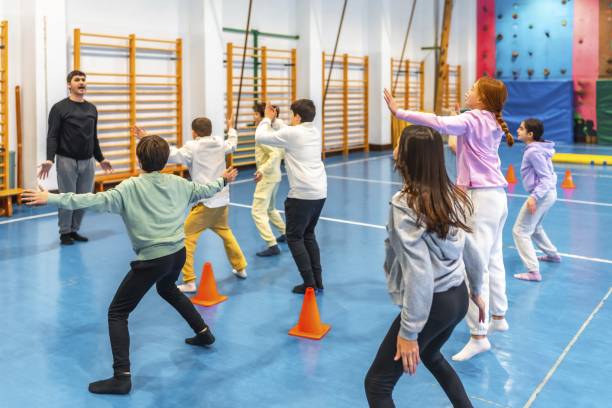When you think of Physical Education (PE), do you imagine dodgeball and jumping jacks? Today’s Physical Education K–12 goes far beyond gym class, it’s a vital part of helping students grow physically, emotionally, and socially.
In an age where screen time is increasing and youth fitness levels are declining, PE offers students a chance to move, de-stress, and build lifelong healthy habits. It also plays a surprising role in improving academic performance, classroom behavior, and even mental health.
This article explores the importance of PE from kindergarten through 12th grade and offers strategies for making it engaging, inclusive, and impactful for all learners.
What Is Physical Education in K–12
Physical Education (PE) in K–12 schools refers to structured instruction that teaches students movement skills, fitness principles, and the value of physical activity.
According to SHAPE America, quality PE programs help students:
- Improve motor skills and physical fitness
- Learn teamwork and leadership
- Understand the connection between health and lifestyle
The Benefits of Physical Education K–12
Physical Health
- Reduces the risk of childhood obesity
- Boosts cardiovascular and muscular strength
- Develops coordination, balance, and flexibility
Academic Success
- Increases blood flow to the brain
- Enhances focus and cognitive performance
- Improves standardized test scores in math and reading
Emotional and Social Growth
- Lowers stress and anxiety
- Builds confidence and resilience
- Encourages collaboration and sportsmanship
How PE Varies Across Grade Levels
| Grade Band | PE Focus Areas |
|---|---|
| K–2 | Basic motor skills, movement games, cooperation |
| 3–5 | Sports skills, fitness circuits, goal setting |
| 6–8 | Team sports, strategy, personal fitness |
| 9–12 | Lifelong fitness, electives (yoga, weights), leadership |
Each level scaffolds physical skills and fitness knowledge appropriate for development.
Common Challenges in K–12 PE Programs
Despite its benefits, PE often faces barriers in schools:
Limited Time and Resources
- Some schools cut PE to prioritize tested subjects.
- Budget cuts may reduce equipment or staffing.
Inconsistent Standards
- PE requirements vary by state, district, or even school.
Student Engagement Issues
- Not all students enjoy traditional team sports.
- Physical insecurities or a lack of ability can discourage participation.
Solutions: Making PE Inclusive and Effective
To meet all students’ needs, PE must evolve.
Diversify Activities
Include:
- Dance, yoga, martial arts
- Lifetime sports like pickleball or frisbee
- Personal fitness tracking and goal-setting
Prioritize SEL in PE
- Use peer feedback and cooperative games
- Teach emotional regulation through movement
- Promote body positivity and self-acceptance
Make Assessment Meaningful
Instead of grading by athletic skill, assess:
- Effort and improvement
- Knowledge of health concepts
- Personal goal achievement
Integrating Technology into PE
Modern PE programs increasingly use digital tools to enhance learning.
Popular Tech Tools in Physical Education:
- Heart rate monitors and fitness trackers
- Video analysis apps for technique feedback
- Virtual PE classes or online challenges
These tools encourage student engagement and self-assessment, especially in middle and high school settings.
PE and Whole Child Education
Educators now recognize that academic success depends on meeting the needs of the “whole child” physically, emotionally, socially, and mentally. PE contributes to:
- Improved attendance (active students skip fewer days)
- Better classroom behavior (movement reduces hyperactivity)
- Stronger peer connections (especially in team settings)
PE During and After COVID-19
The pandemic disrupted physical activity for many students. Online learning meant PE became optional—or vanished entirely.
Post-COVID, schools are prioritizing:
- Outdoor activities
- Fitness-based learning over traditional sports
- Mental health integration through mindful movement
Read Also: How Arts Education Enriches K–12 Learning and Student Growth
Conclusion
Physical Education isn’t just a break from academics; it’s a powerful tool to boost student health, brain function, confidence, and character. A strong Physical Education K–12 program supports the whole child and lays the foundation for lifelong wellness.
By adapting activities, using tech tools, and focusing on inclusion and well-being, schools can make PE something every student looks forward to, not avoids. Let’s get students moving not just for grades, but for life.
FAQs
1. Why is Physical Education important in K–12 schools?
PE improves health, brain function, and emotional well-being, helping students succeed in and out of the classroom.
2. What activities are part of a modern PE curriculum?
Modern PE includes team sports, yoga, dance, personal fitness, and digital tools like heart rate monitors or apps.
3. How often should students have PE?
SHAPE America recommends 150 minutes per week for elementary and 225 minutes for secondary students.
4. What if students aren’t athletic?
Inclusive PE focuses on effort, participation, and personal improvement, not just performance.
5. Can PE improve academic achievement?
Yes! Studies show that physically active students perform better on standardized tests and have stronger focus and behavior.
